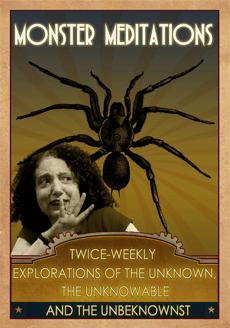I know the title of this post sounds like Lewis Carroll style nonsense, but it’s not. I often set stories in real places. The concrete details of a real location add a context that can make even the most fantastic tales seem more credible. I could write a werewolf chatting up an NYU grad student at McSorley’s Old Ale House — a popular pub in the East Village that has been in business since 1854 — and borrow the bar’s credibility for my incredible story because so many people have either been to the bar or heard of it. In my second Monster novella, BRAM STOKER’S SUMMER SUBLET, most of the locations are real and I hope readers will visit Tompkins Square Park, The Metropolitan Museum’s Egyptian Collection and some of the other very real locations. Descriptions of real places help ground the story.
On the other hand, sometimes the real place doesn’t exist or suitable real places are associated with other stories (or films) and are too thoroughly connected with other works of fiction. The monster on the top of the Empire State building is King Kong — another monster lurking there would have to contend with his very large shadow. It’s possible to write such a story (and I just might try) but ignoring the existing monster would be pretty strange.
That’s when inventing a place and making it as real as a real place is the writer’s task. The upside is that you can create exactly the kind of location that suits your story — choose the architectural style of the critical building, place the river on the east side of the town, stick a cave in a mountain, build a house with a spooky attic, choose a forked road or even create an entire planet that fits your story.
It’s also a challenge.
When I selected the winner for the Candy’s Monsters Real Estate Contest, I was enchanted by the idea of setting a vampire story in the real Loew’s Paradise — a beautiful old theater in the Bronx that opened in 1929. I also realized that if I chose to set the story today, I’d have to account for the history of the theater and its varied incarnations over the years. My solution was to create another theater from a similar period in New York’s past and place it in another part of the city. I did this by reading about the Paradise and other classic movie houses built during the depression. The first step was choosing between a real, real place and creating one with words — and going with the choice that serves the story best.





I have used a few real places in stories but I tend to keep them nameless or change the names. It can be so easy to get caught up in the history that already exists in a location and that can take away from the world I am working to build.
Exactly!
Sometimes the real place is PERFECT — history and all. But when it’s close to perfect, or top-loaded with unrelated references, it’s time to invent a place. Of course invented places have to be created with extra credibility. Plunking down a sophisticated sushi restaurant in a small town that actually has only one cafe and a burger & beer joint is not going to pass the reality check.
I had a lot of fun creating the theater in Queen of the Movies. It’s a true combination of other classic movie palaces and my imagination.